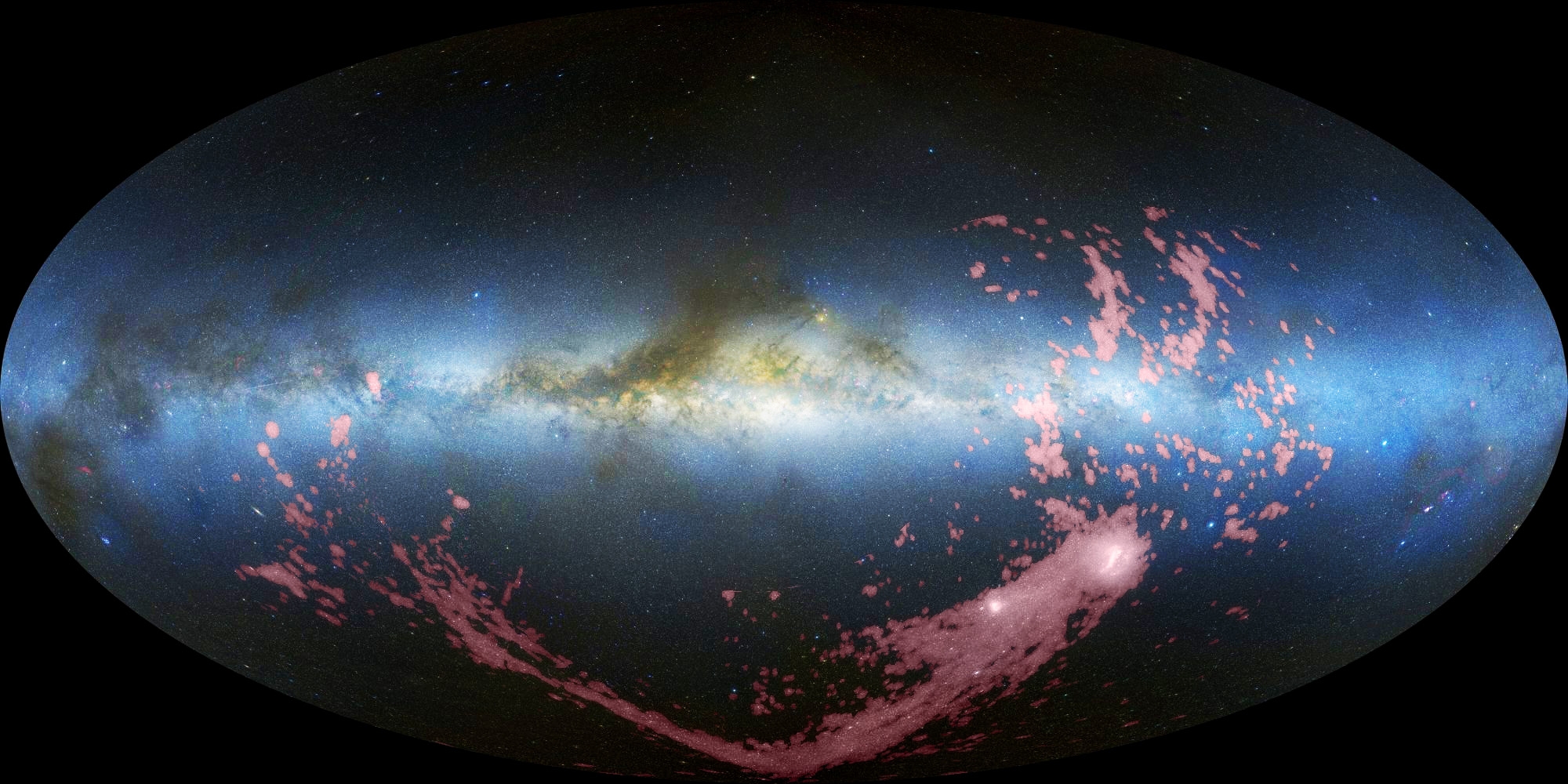







| BOOKS | F. A. Q. | ARTICLES | TALKS | ABOUT KEN | DONATE | BEYOND OUR KEN |
|---|
By Ken Croswell
Published on Scientific American (April 4, 2014)

Credit: D. Nidever et al, NRAO/AUI/NSF/ and A. Mellinger, Leiden-Argentine-Bonn (LAB) Survey, Parkes
Observatory, Westerbork Observatory and Arecibo Observatory.
For the first time, astronomers have detected stars in an enormous stream of gas shed by the Magellanic Clouds, the two brightest galaxies that orbit our own. Sought for decades, the newfound stars are young, which means they formed recently, when the Magellanic gas collided with gas in the Milky Way. The newborn stars offer insight into processes that occurred in the ancient universe, when small, gas-rich galaxies smashed together to give rise to giants like the Milky Way.
"This is the one and only galaxy interaction we can model in very much detail," says Dana Casetti-Dinescu, an astronomer at Southern Connecticut State University, who notes that other collisions of gas clouds between galaxies are farther away and thus harder to observe. "For more distant systems that interact, we don't have the wealth of information."
Some two dozen galaxies revolve around our own but only the Magellanic Clouds shine so brightly that stargazers can see the pair with the naked eye. What really sets these two apart is their vigor: unlike all other Milky Way satellites, the Magellanic Clouds abound with gas, the raw material galaxies use to create new stars.
The Magellanic Clouds are certainly nearby: the Large Magellanic Cloud is just 160,000 light-years from Earth, whereas the Small Magellanic Cloud is 200,000 light-years distant and 75,000 light-years away from its partner. As the two galaxies orbit the Milky Way, they probably orbit each other, too.
A closer look at the Magellanic Clouds reveals more details. In the early 1970s radio astronomers discovered a long stream of gas that trails behind the two galaxies in their orbit around us. This gas, named the Magellanic Stream, consists mostly of neutral hydrogen atoms, which broadcast radio waves that are 21 centimeters long. A shorter gaseous component leads the Magellanic Clouds and is therefore called the Leading Arm. From the tip of the Leading Arm to the far end of the Magellanic Stream, this gaseous strand is at least 200 degrees long and stretches across more than half a million light-years of space.
Just as the Moon lifts the terrestrial seas, the Large Magellanic Cloud's gravitational pull has torn most of this gas out of the Small Magellanic Cloud, whose grasp on its contents is less secure. Stars should also have spilled out of the Magellanic Clouds. Although both stars and gas exist between the Magellanic Clouds, no one has ever found any stars in either the Magellanic Stream or the Leading Arm.
Until now. Casetti-Dinescu and her colleagues used the 6.5-meter Walter Baade telescope at Las Campanas Observatory in Chile to uncover six luminous blue stars in the Leading Arm. "They are formed in situ," she says. "They have to be, because they're too young—they don't have enough time to travel from the Clouds to their current location in their lifetime." Five of the six stars are about 60,000 light-years from the Milky Way's center, near the periphery of our Galaxy's disk of stars.
Like most spiral galaxies, the Milky Way maintains a vast reservoir of hydrogen gas that encircles its stellar disk. So the newborn stars could have originated in our Galaxy. But the stars share the velocity of gas in the Leading Arm, suggesting they arose as its gas crashed into the Milky Way's outer gas disk, compressing the Arm gas until it spawned stars. The astronomers report their discovery in the April 1 issue of The Astrophysical Journal Letters.
"This is the first credible evidence of stars associated with the Leading Arm," says David Nidever of the University of Michigan, who is conducting his own search. He's especially intrigued by a sixth and more distant star the astronomers have spotted. Located 130,000 light-years from the Galactic center—about twice as far as the other stars—it shines well beyond the edge of the Milky Way's stellar disk, in the vast outer halo beyond. The star has a spectral type of O6, corresponding to a surface temperature of 44,000 Kelvin. Such a hot star burns brightly but briefly; it formed a mere 1 to 2 million years ago. "It seems like that star really has to have been born in the halo," Nidever says.
The Milky Way's outer halo, although mostly starless, possesses hot diffuse gas that greets infalling gas in the Leading Arm. "This material is plunging through the hot halo of the Milky Way," Casetti-Dinescu says. Magellanic gas hit the hot halo gas, she thinks, getting squeezed and forging the short-lived star.
Although the stars owe their births to gas from the Magellanic Clouds, they now revolve around a new master: the Milky Way Galaxy, which has enhanced its already significant grandeur by grabbing gas from its two most flamboyant satellites and sculpting it into new stars, a process our Galaxy must have exploited numerous times in ancient epochs as it grew into a giant.
Ken Croswell earned his Ph.D. in astronomy from Harvard University and is the author of The Alchemy of the Heavens and The Lives of Stars.
"An engaging account of the continuing discovery of our Galaxy...wonderful." --Owen Gingerich, The New York Times Book Review. See all reviews of The Alchemy of the Heavens here.
"A stellar picture of what we know or guess about those distant lights."--Kirkus. See all reviews of The Lives of Stars here.
| BOOKS | F. A. Q. | ARTICLES | TALKS | ABOUT KEN | DONATE | BEYOND OUR KEN |
|---|